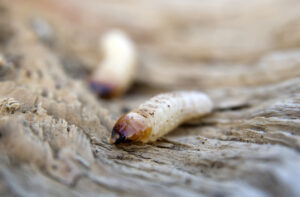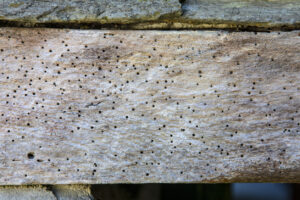
Need Help? Call Us On 0161 776 9832 For Expert Pest Control Advice On How To Identify Pest Infestations And Help Solve Your Pest Problem.
Professional Cheadle Hulme Woodworm Treatment
What is a woodworm?
 Woodworm is the generic name given to the larval stage of several different species of woodboring beetles. The larvae are usually white with a curved shape, while the adults vary in colour and appearance according to species. The beetles evolved in forest habitats where they fed on dead or living wood. Some have since become pests that damage timber and furniture in human dwellings, though they still prefer to feed on damp wood.
Woodworm is the generic name given to the larval stage of several different species of woodboring beetles. The larvae are usually white with a curved shape, while the adults vary in colour and appearance according to species. The beetles evolved in forest habitats where they fed on dead or living wood. Some have since become pests that damage timber and furniture in human dwellings, though they still prefer to feed on damp wood.
The most common woodworm species found as pests in the UK include:
- Common furniture beetle (Anobium punctatum)
- Deathwatch beetle (Xestobium rufuvillosum)
- House Longhorn beetle (Hylotrupes bajulus)
- Powderpost beetle (Lyctus brunneus)
The common furniture beetle is the most frequently encountered species and is responsible for about 75% of all structural and cosmetic damage to furniture and other wooden structures. All types of woodworm can be treated with Cheadle Hulme woodworm treatment spray available from Young's Pest Control.
Woodworm life cycle
There are several stages in the woodworm life cycle:
- Eggs are laid on a wooden item.
- Larvae hatch from the eggs and begin feeding on the wood, creating tunnels.
- Larvae pupate close to the surface of the wood.
- Adult beetles emerge from the pupae and breed, beginning a new cycle.
Because the completion of the life cycle may take several years, the woodworm infestation may be unnoticeable for a while. The eggs are small and difficult to spot with the naked eye and therefore timber used in a new construction may be infested with eggs but the problem becomes visible only when the larvae start feeding. Luckily, professional treatment for woodworm can be applied at any point to limit the damage and prevent it from recurring.
Signs of a woodworm infestation
 Wooden items infested with woodworm have round or oval holes with a typical diameter of about 1 to 2 mm (apart from the much larger holes created by the house longhorn beetle grubs). If the grubs are present, there may also be gritty powder around the holes. Adult beetles can be spotted between May and October - the holes they leave when they emerge from the pupae are larger in size than the ones caused by larvae.
Wooden items infested with woodworm have round or oval holes with a typical diameter of about 1 to 2 mm (apart from the much larger holes created by the house longhorn beetle grubs). If the grubs are present, there may also be gritty powder around the holes. Adult beetles can be spotted between May and October - the holes they leave when they emerge from the pupae are larger in size than the ones caused by larvae.
Cheadle Hulme woodworm removal treatment
Before the application of Cheadle Hulme woodworm treatment furniture spray, furniture should ideally be taken out of the house to prevent the infestation from spreading to other items. Apart from using professional Cheadle Hulme woodworm treatment spray, it is also strongly recommended that any issues with damp are dealt with since damp wood is much more susceptible to further infestations than dry wood.
When considering the right treatment for woodworm removal, it's important to determine the following:
- Is the infestation active?
- What species is causing it?
- How extensive is the damage?
For the most effective Cheadle Hulme woodworm treatment, furniture and timber with suspected infestation can be assessed by professionals at Young's Pest Control. Any suspected infestation should be dealt with promptly - if the pests are left alone they can cause serious damage and weaken important structures such as floorboards.
